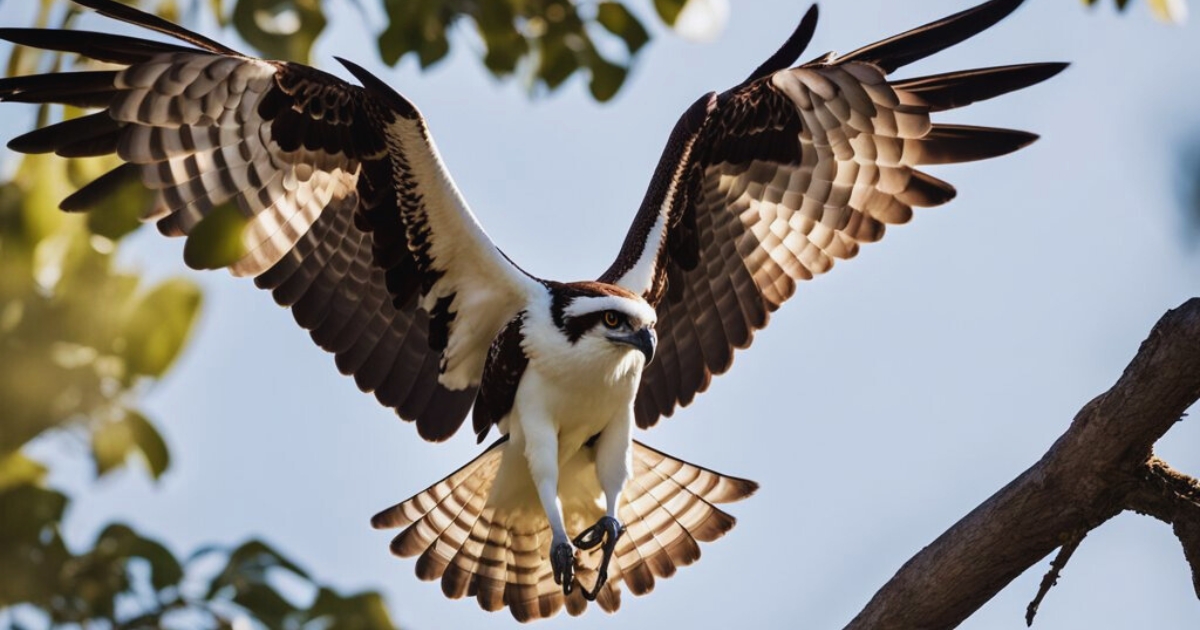The osprey is a large fish-eating bird of prey that is found on every continent except Antarctica. Sometimes called the fish hawk or sea hawk, ospreys are widely recognized for their fishing behavior and ability to plunge into water to catch fish. These unique raptors have brown and white plumage, angular wings, and fiercely hooked talons.
Ospreys build large nests high up in trees, on man-made structures, and on cliffs overlooking bodies of water. They migrate long distances and have one of the largest geographical ranges of any bird species. As apex predators that feed on live fish, ospreys play an important role in food webs and ecosystem health.
While osprey populations experienced significant declines in the 20th century due to pesticide use and habitat loss, conservation efforts have helped them rebound. These majestic birds continue to fascinate humans and serve as symbols of power, vision, and resilience.
Physical Characteristics of Osprey Bird
The osprey has several distinctive physical features that aid its lifestyle as a fish-hunting raptor. Its body shape, plumage, talons, and reversible outer toe all help the osprey thrive as a specialist predator.

Size, Weight, and Wingspan
Ospreys measure 19 to 26 inches (48 to 66 cm) in length, with wingspans ranging from 59 to 70 inches (150 to 178 cm). They weigh between 2.2 and 4.4 pounds (1 and 2 kg). Their long, narrow wings allow for easier maneuverability when hunting over water.
Male and female ospreys are close to the same size, with females typically weighing slightly more than males. The osprey’s size places it between a large hawk and an eagle. Despite their size, ospreys have relatively slender, lightweight bodies adapted for fast flight and diving.
Plumage and Coloration
Adult ospreys feature brown upperparts and predominantly white underparts. The head is white, with a broad brown stripe through the eye. They display dark carpal patches on the bend of each wing.
Juvenile ospreys have buff-colored tips on their feathers, giving them a speckled appearance until they reach maturity at 3 to 4 years old. As juveniles age, their plumage gradually transforms into the adult color pattern.
The osprey’s dark upperparts help camouflage the bird during flight against the dark water below. The pale underparts make the osprey less visible against the sky for fish looking upward.
Differences Between Male and Female Ospreys

Males and females have nearly identical plumage, making gender difficult to determine visually. However, females tend to be up to 25% larger than males.
Females also have a distinctively speckled brown and cream breast band, while the male’s breast band leans solidly brown. Juveniles of both sexes have the speckled breast band until maturity.
During courtship, behavioral differences help distinguish males from females. Males perform dramatic aerial displays, while females assume a begging posture. Vocalizations also differ between the sexes.
Habitat and Range of Ospreys
Ospreys thrive near open waterways and coastlines on every continent except Antarctica. Though they migrate long distances, they typically return to breed in the area where they were born.
Breeding Range and Migration
The osprey’s breeding range consists of temperate and subarctic regions of North America, Europe, and Asia. Populations in the northernmost latitudes migrate south for winter, while those in warmer southern climates remain year-round residents.
Some northern ospreys make astonishingly long migrations, covering 2,500 to 8,000 miles (4,000 to 13,000 km) round trip. North American ospreys migrate south to the Gulf Coast, Central America, and northern South America before returning north to breed again.
Nesting Habits
Ospreys build large nests to raise their young, typically in trees or on man-made structures near water. Nests are composed of sticks, grass, seaweed, and other materials and can measure up to 5 feet (1.5 m) across and 3 feet (1 m) deep.
Good visibility and proximity to optimal fishing areas are key factors in nest site selection. Ospreys favor tall trees, channel markers, power poles, telephone poles, artificial nest platforms, and even abandoned human structures.
Nest re-use over consecutive years helps pairs return to sites where they’ve successfully raised young. Some osprey nests remain active for decades.
Diet and Hunting Behavior
As specialist fish hunters, ospreys are well-adapted to locate, dive for, and catch prey underwater. Their diet, hunting style, and anatomy reflect a primary focus on catching live fish.
Prey and Hunting Style
Fish make up 99% of the osprey’s diet. They mainly prey on fish ranging from 4 to 18 inches (10 to 40 cm) long that weigh 0.5 to 2 pounds (225 to 900 grams).
Ospreys hunt by flying over water, scanning for fish near the surface, hovering momentarily, and then plunging feet-first to snatch prey in their talons. They primarily hunt shallow waters within 3 to 6 feet (1 to 2 meters) deep.
Fishing Adaptations
Specialized adaptations give ospreys an edge when hunting fish:
- Sharp talons – Ospreys have one backward-facing toe and spiky foot pads to grip slippery fish.
- Reversible outer toe – They can pivot one outer toe front or back to optimize catching and carrying fish in-flight.
- Cloaca – Their reproductive/excretory vent seals the middive to prevent wetting their insulation.
- Nasal valves – Valves seal while diving to prevent water from entering their nostrils.
- Dense oily plumage – Their feathers resist water absorption to stay warm after diving.
- Modified optics – Nictitating membranes protect their eyes underwater.
Reproduction and Life Cycle
Ospreys follow elaborate courtship rituals, culminating in monogamous breeding pairs. They lay eggs and raise young together in nesting territories near high-quality fishing sites.
Courtship and Mating
Breeding season courtship begins with aerial displays by the male over the nest site. These displays communicate possession of the site and attract potential mates.
If a female approves, she will join the male’s aerial maneuvers. Once paired, the male performs dramatic sky-dance dives while presenting the female with a fish mid-flight.
Ospreys form monogamous pair bonds that may last for life, though a new mate may replace a deceased partner. Pairs return to the same nesting area and often the same nest for breeding each year.
Nesting, Eggs, and Raising Young

Once paired, the female lays a clutch of 1 to 4 eggs within a week. The eggs are blotchy brown and incubated for 5 to 6 weeks before hatching.
Both parents share brooding and hunting duties. They feed newly hatched chicks by tearing fish into bite-sized shreds. The chicks fledge at 8 to 10 weeks and remain dependent on their parents for an additional 4 to 8 weeks.
Most juveniles spend 2 to 3 years wandering widely before returning to breed in their natal range. Ospreys reach sexual maturity and may begin breeding as early as 3 years old.
Conservation Status and Threats
Populations of osprey declined in the mid-20th century due to toxic pesticides, habitat loss, and persecution by humans. Conservation efforts have helped them rebound significantly.
Historical Declines
Widespread use of the pesticide DDT thinned osprey eggshells, causing catastrophic reproductive failure from the 1940s through the early 1970s. During this time, osprey populations dropped an estimated 80-90%.
Other factors like habitat destruction, nesting disturbance, illegal shooting, and accidental trapping contributed to the decline in osprey numbers. By the 1970s, many considered them endangered.
Current Conservation Status
In the U.S., ospreys were federally listed as endangered up until 2009. Conservation initiatives helped populations recover enough to designate them as a protected species of least concern.
Ospreys remain listed as endangered at state levels in some areas where populations have been slower to rebound. Globally, they are considered a species of least concern on the IUCN Red List.
Ongoing Threats
Despite recovery efforts, ospreys still face threats from:
- Habitat loss and degradation
- Collisions with vehicles, turbines, and power lines
- Contaminants like heavy metals or oil spills
- Human disturbance of nest sites
- Entanglement in fishing gear
Sustained conservation work is needed to protect vital habitat and reduce disruptive human impacts.
Cultural Significance and Symbolism
The osprey’s fishing prowess, far-ranging migrations, and comeback from endangered status have made it an iconic species laden with symbolism.
Use as a Symbolic Animal
The osprey represents tenacity, abundance, power, and vision across many cultures. Native Americans consider the osprey a peacemaker who signals rivers and lakes teeming with fish.
Zuni and Navajo tribes revere the osprey as sacred. Overall, their dramatic hunting style and resilience capture human imagination.
Appearances in Folklore and Mythology
Ospreys feature prominently in folklore and mythology as bringers of fish and omens. Norse legends claim osprey patrol waters to report fishing conditions to the goddess Freya.
According to Scottish tales, ospreys arrive with the first herring run and summon other wildlife to feast. Across mythology, ospreys portend both good and bad fortune.
Conclusion
In summary, the osprey is an iconic fish-hunting raptor uniquely adapted to catch prey in water. These brown and white seabirds build immense nests to raise young near open waters where fish are abundant. Though osprey populations suffered from pesticide use and persecution in the past, conservation efforts have helped them rebound. Their amazing resilience and fishing abilities continue to inspire human culture. Looking ahead, maintaining protections and habitat will be key so ospreys can thrive.
FAQs about Ospreys
Q: What does an osprey look like?
A: Ospreys are large raptors with brown upperparts, predominantly white underparts, and a distinctive dark brown stripe through the eye. Juveniles are mottled brown and white before gaining adult plumage around age 3-4.
Q: Where do ospreys live?
A: Ospreys thrive near open waterways and coastlines. They breed in temperate and subarctic regions of North America, Eurasia, Indonesia, and Australia. Northern populations migrate south for winter while southern ones remain year-round.
Q: How do ospreys hunt?
A: Ospreys hunt by flying over water, hovering above prey, and plunging feet first to snatch fish near the surface with their sharp talons. They mainly catch fish 4-18 inches long weighing 0.5-2 pounds.
Q: Why did osprey populations decline?
A: Widespread DDT use thinned osprey eggshells causing reproductive failure. Habitat loss and persecution via shooting, trapping, and disturbance also contributed to declines. By the 1970s, ospreys were endangered.
Q: What is the osprey’s conservation status today?
A: Thanks to reduced pesticide use and protected habitats, osprey populations have rebounded significantly. While still threatened locally, most now have a conservation status of Least Concern. Ongoing protections are needed to ensure their survival.

